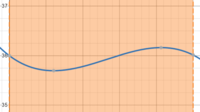Some of what is being discussed is what was behind my comments:
I had graphed this:
View attachment 25963
I saw that if the period was 28, there would be a jump; but
the problem doesn't actually say anything about what the period is, except that it is "fixed", and that
for humans it is 28.
If it were 25, the periodic function would be more reasonable:
View attachment 25964
But
the problem doesn't even say to start at 0. That, to me, is what makes this a poorly written problem! Far too much is left to guessing. Of course, we can be reasonably sure that the local max and min are the "right" answers, but it doesn't say what needs to be said.
Of course, all that's going on here is an attempt to fit a simple problem (find the local max and min of a polynomial) into a "real-life" problem that isn't a good fit for it.




